GM 6.2L LS3 Engine Specs, Problems, Reliability, Info

6.2L LS3 Small Block V8 Engine Info
The GM 6.2L LS3 V8 engine is an all-aluminum, naturally-aspirated, gasoline 6.2-liter, V-shaped, high-performance engine that is a member of GM's Gen IV Small Block family and successor to the 6.0-liter V8 LS2 motor. The LS3 engine was produced between 2007 and 2017 and was used in high-performance GM vehicles, such as the Chevrolet Corvette and the Chevrolet Camaro SS. This powerful V8 was also used by Australian car manufacturer Holden or HSV (Holden Special Vehicles) in some domestic models: HSV E Series, Holden WN II Caprice, Holden VF II Commodore and more. In this article, we will explore the details of the LS3 engine, and look at its specifications, design, performance, and reliability.
6.2L LS3 Engine Overview
The LS3 V8 engine has a lightweight aluminum cylinder block with a deep-skirt design, cast iron sleeves, and six-bolt main caps. It comes with cast iron (wet sump) or forged steel crankshaft (dry sump), 6.098-inch-long forged powdered metal I-beam connecting rods, and flat-top cast aluminum pistons. The majority of LS3 engines came with a wet sump, but Corvette models equipped with manual transmission had a dry sump oiling system. Dry sump LS3 also had different oil pump (GM part number 12623097).
Heads are also made of aluminum alloy. They feature 2 valves per cylinder, die-cast roller rocker arms, rectangle intake ports, D-shaped exhaust ports, steel hollow stem intake valves and steel solid stem exhaust valves. Intake valve diameter is 2.165 inches (50.8 mm). Exhaust valve diameter: 1.590 inches (40.4 mm). The engine utilizes a pushrod OHV design with a single camshaft. The length of the steel pushrods is 7.385 inches. The camshaft is driven by a chain. The stock LS3 camshaft specs: 204/211 duration (intake/exhaust), 0.551 in./0.525 in. valve lift (intake/exhaust). The LS3 does not have AFM and VVT systems, compared to the 6.2L L99 engine used in the 2010-2015 Camaro SS with automatic transmission.
The engine features conventional electronic port fuel injection. Fuel injector flow is 42 lb/hr at 58 psi. The intake manifold is made of composite material (plastic) and is fitted with an electronic throttle body (called "drive-by-wire" or Electronic Throttle Control (ETC)). Ignition is also electronically controlled, and each spark plug has an individual coil. The LS3 comes with an advanced 58X crankshaft position encoder to ensure accurate ignition timing. All electronic systems are managed by the engine control module (ECM) — GM E38.
Engine Specs
Wixom, Michigan, USA (dry sump LS3 only)
466 lbs (211 kg) - Corvette Grand Sport Manual
9.9L (10.5 qt) – dry sump
Oil recommendations and capacity may vary depending on the car model, year, and market. Please check the service manual specific to your vehicle!
6.2L LS3 Engine Problems
The LS family is known for its reliability, but some engines may have more or fewer problems. The 6.2-liter LS3 V8 engine is a relatively simple version without the VVT system or AFM (cylinder deactivation technology) known for reliability issues with valve lifters and excessive oil consumption. The LS3 engine is widely considered to be a very durable and reliable powerplant with great performance upgrade capabilities. However, it is a very powerful V8 engine used in sports cars, and over time, some problems and breakdowns may occur due to high level of stress and abuse. Let's look at some of the most common problems with LS3.
Dropped Valve Seats
Valve seats are made of cast iron, while heads are aluminum. The seat may become loose because cast iron and aluminum have different expansion rates. This is a well known problem with LS rectangle‑port heads. They don't like being overheated, and having any cooling issues increases the risk of the valve seats falling out.
Cracking Cylinder Sleeves
The LS3 engine has an aluminum block with cast iron sleeves. During the production process, these sleeves are bored in place, that sometimes lead to variations in thickness from side to side, causing weak spots, which prone to cracking after significant wear or when pushed hard.
Cam Bearing Damage
Cam bearings in the LS engine are very sensitive to oil conditions. They do not last very long without regular oil changes and using good quality oil. The most effective way to extend their life is to change the oil at least every 5,000 miles or less and use a high-quality, correct grade synthetic oil.
Low Idle
Some owners have reported issue with idling speeds that are too low, less than 650 RPMs. This is a common problem with this engine, caused by a dirty throttle body and carbon buildup on the Idle Air Control (IAC) valve.
GM LS3 Reliability Summary
Drawing the line, despite some flaws, the LS3 is a very durable and robust pushrod V8 engine. It has a strong foundation built to handle high-performance demands, it responds well to modifications, lots of aftermarket parts available. Most of its problems stem from poor maintenance, such as using low-quality oil, wrong oil viscosity or issues with the cooling system. Well-maintained 6.2-liter LS3 engines in stock form often show an excellent longevity — over 250,000 miles. Under ideal conditions and with regular oil changes, using a full synthetic oil, this LS engine can last even 300,000 to 400,000 miles.
